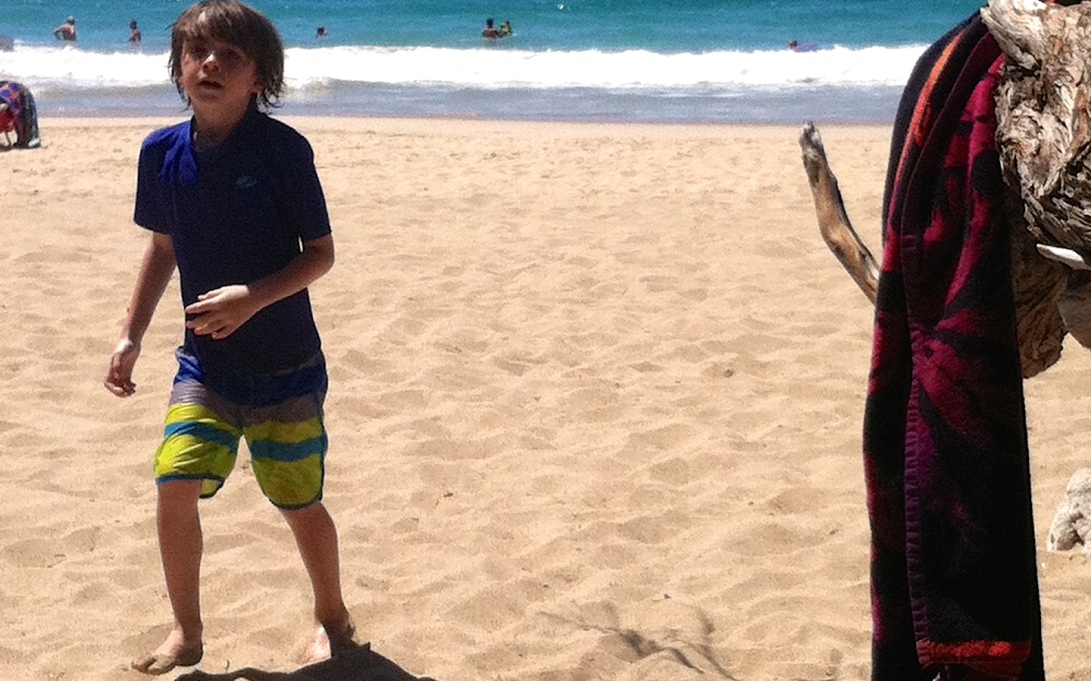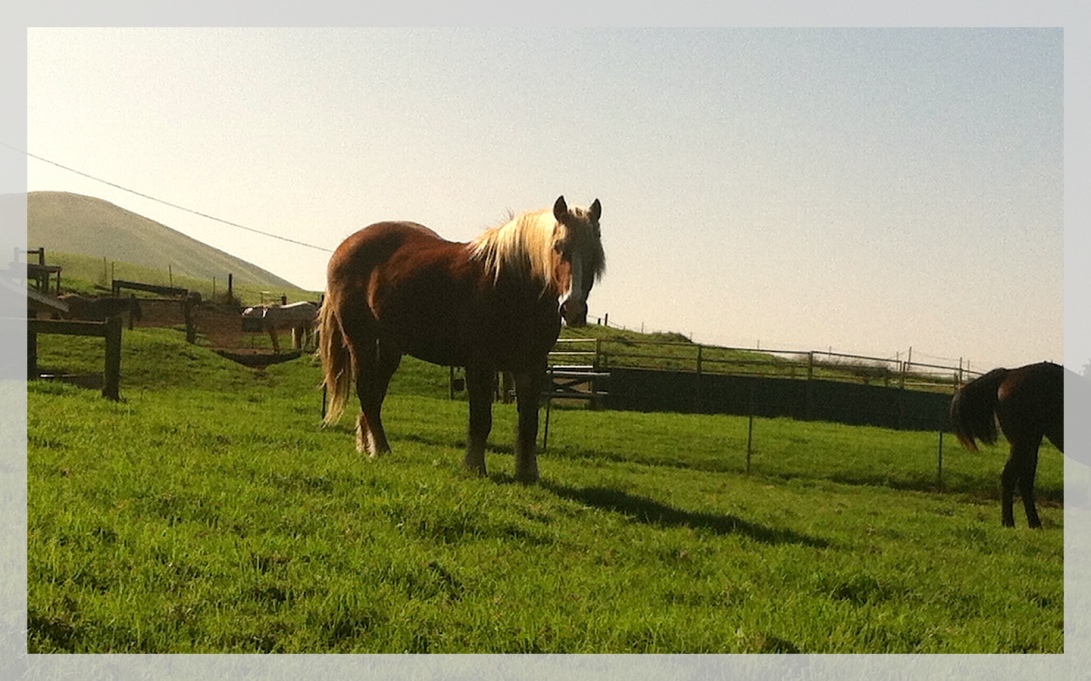Before there was a change of scenery, there was the dream of a change of scenery. In September, as our summer ended, Kellie and I talked about Hawaii. We talked about jumping into warm ocean waters and hiking into Turtle Bay. I continued the dream by searching the internet one night while the rest of my family slept. If I could find us a space away from the resort scene and priced to our budget, then maybe we would go. It only took me a few clicks to find a little white house for rent on an 8,000 acre ranch. The photos showed green hills and rainbows, ocean views and horses and sheep. I showed the listing to Kellie and we booked it. Later, I showed it to Smoke to convince him that Hawaii was a place he wanted to go. For the months that followed, I sometimes clicked through the slideshow to remind myself of the place I’d eventually be. Just the thought of the hills and the warm air helped me breathe more deeply.
Before there was a change of scenery there were weeks of planning and packing. There were fluctuating airfares and impossible travel times. There was an impulse to cancel the trip if it meant a midnight layover in Anchorage or a 10 pm departure. There were the logistics of parking cars and renting cars and transporting car seats and packing toiletries and medicines and swimsuits and all the while feeling that, upon arrival, I would discover some essential item I’d forgotten.
The change of scenery arrives the moment I step off the plane and descend to the tarmac and my jeans are already sticking to my thighs. There are palm trees in planters just past the gate and Smoke has already put on his sunglasses. I have to keep Stump from climbing on the baggage carousel. We make a pile of bags on a patch of grass and wait for Kellie to pick up the rental car. My kids strip off their long sleeve shirts and climb along the walls, bare-chested. A pair of ladies with stiff hair make phone calls and give me the side-eye.
Seen from the beach: turquoise waves that climb and crest, and then stir up brown sand as they fall; off in the distance, whale spouts and whale body parts—the flash of a tail or the curve of a back; closer to shore, a scattered row of humans waits in that magic spot where the waves swell; some of them hold boogie boards; some of them dive into waves and come out the other side; some of them glide with just their bodies. On the shore my kids dig in the sand and wait for the ocean to fill the hole they’ve made. They throw sand bombs and bury each others’ legs. Sometimes they run off and for a long minute their bodies blend in with all of the other bodies and action. I run along the beach craning my neck, trying to see between the tanners and the Frisbee-throwers until finally I see the swim trunks I recognize.

Seen from inland: vistas, storm clouds, araucaria columnaris. A wild pig with three piglets, all of them fighting to nurse. Wild billy goats and their families hiding in the scrub, bleating (we hear them before we see them). Friendly horses at sunset. A Hawaiian short-eared owl, soaring in daylight. At twilight another one swoops in front of our headlights and then lands at the edge of the road. It stands there, still and silent, and stares us down.

The packing never ends. In the mornings we move food from the refrigerator to the cooler. In the evenings we move food from the cooler to the refrigerator. We pack towels and sunscreen and changes of clothes. We pack Benedryl and epi-pens in case of bee emergencies. I am constantly checking my purse to make sure my wallet is still there. I am constantly checking on my children’s skin for signs of sunburn. I know that I am supposed to reapply sunscreen every 90 minutes, but they are constantly wet and covered in sand.
Smoke, my older son, joins the line of boogie boarders on day 3. This keeps him busy and smiling for the better part of an hour, until a large wave sneaks up and topples him. The rocks in the sand scratch his back in several spots. He bleeds a little. Kellie helps him find his footing, wraps him in a towel, and sets him down in a beach chair, but he won’t stop screaming. “I hate this beach,” he tells me. I tell him we’re not going to leave just yet. He spends the next forty minutes pouting and writing in the sand with his toes in all caps: I HATE THIS BEACH. I try to laugh, but the truth is I’m uncomfortable. I also don’t want to be the parent whose kid complains about his Hawaii vacation. I don’t want to be the parent who berates her kid for not loving every minute of his Hawaii vacation. I keep quiet and let Smoke do his thing. Each time he tries to write his sentence, a wave comes and washes it away before he can finish, which is actually pretty funny. Eventually, he recovers. We leave the boogie board on the shore and jump in the waves together.
On the same beach Stump climbs the koa trees that grow at odd angles over the beach. It a good task for him—it keeps him happy but it requires supervision. Kellie and I stop packing our personal reading materials in our beach bags–there’s no chance of sitting for longer than a moment. Every day I repeat the following phrase in my mind: The Family Vacation. I say it to remind myself that this isn’t a personal holiday, but instead an exercise in intensive parenting, in togetherness. It’s not about rest or comfort or indulgence, so much as it is about building something, about offering my children a new landscape for their memories to hold, a landscape that we can share in future years. I had a chiropractor once who would tell me to “go to Hawaii” before she adjusted the vertebrae in my neck. It was her way of asking me to relax so that she could do her work, but every time she said it I pictured a pier just south of Hawi where the yellow tangs swim. Hawaii to me was not an abstraction, but a place in my brain that I could access. I want my kids to have those places too.

At night, in the dark, I cannot find my way through our rental home. I walk with both hands out in front of me, reaching, feeling, waiting for my eyes to adjust. They don’t. I think I can make out faint shapes—a door, a bed—but I am mistaken. I run into a wall where I thought I’d find a door or a door where I thought I’d find a wall. The truth is simple: my body hasn’t learned this place.
When Stump is especially tired, he cries for the home he knows. As we drive on the back roads after sunset, he says, “I don’t want to go to our Hawaii home. I want to go to our real home.” I look out over the ocean at the scattered lights along the coastline and I look for words to explain how very far away our real home is, and what two more days means, how to help him understand that our real home is unreachable to us at the moment, but that we haven’t left it behind forever.
I never find words for this, and it doesn’t matter. Kellie parks our rental car at the end of the driveway and I carry Stump through darkness and into the house. His brother has beat us inside and already turned on the lights and we can find everything we need. We read one of the books I packed from our hometown library and he is asleep before I reach the last page.
I always enjoy reading your postings.
LikeLike
Thank you Gail!
LikeLike
You’re right about the common memories being worth the work. And the “filter of nostalgia” exists for everyone. Collin and I now reminisce about how we forgot to bring any of his foot ware on a camping trip. On another trip, he had a brief desire to go home. Then he won a frog hopping contest and was mentioned in the local newspaper. These experiences are family legend and the stuff of school essays. Collin recently told me he liked his childhood because it was “fun”. That’s all I ever wanted, and it is more work than it sounds.
LikeLike
I love these different moments all captured in one post. And the realness of it all. I especially loved STUMP trying to write on the sand how much he hated the beach, you trying not to laugh, and how that moment passed into the next.
LikeLike
very well written
LikeLiked by 1 person
Nice scene
LikeLike
Follow me.
LikeLike